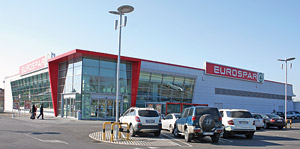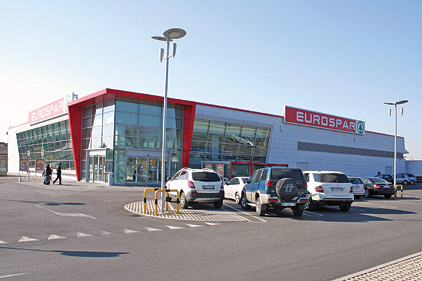
|
| A supermarket in Italy was the subject of a study on what mechanical changes moves a store from the ranking of “traditional” to “evolved” to “excellent” energy savings. |
New technologies and new approaches to supermarket refrigeration have been on going over the years with the primary goal being to reduce energy consumption.
Now a study from Carel has tried to get a precise handle on energy savings at various levels of upgrades and at the same time has assigned some new terminology to the steps — ‘traditional,’ ‘evolved,’ and ‘excellent.’
For the study, Carel worked with Spar International, a supermarket chain; and FriulFrigo, an installation and maintenance company.
The primary objective was to focus on a way to assess the extra costs and time needed to pay back the investment. The research looked at different methods and see how each contributed to savings and payback.
The test protocol was managed by the Carel Thermodynamic Research Center. The site chosen was a Eurospar supermarket in Italy that opened in November 2009. In its initial setup, there were 15 medium-temperature cases and 11 low-temperature cases. On the medium temperature side there were three compressors, including an inverter-driven compressor and condenser coils with six inverter-driven fans. On the low-temperature rack, there were three compressors including an inverter-driven compressor, subcooling heat exchanger, and condenser coil with four inverter-driven fans.
In a report issued by Carel, it was cited what it called a different approach from “the simple applications of new solutions.”
Those differences included:
• “Design forecasts, laboratory tests, and real results are able to be compared in different normal operating conditions.”
• “Each function can be activated and deactivated individually to measure its effectiveness, repeating the checks more than once with the same load conditions.”
• “The tests, in fact, used standard configurations. When any parameters changed the measurements were repeated.”
One finding, according to Carel, was that “through careful choice of the components and good installation of the system, significant savings can be achieved even with limited effort and low additional costs.”
Traditional
The report first noted a traditional supermarket with mechanical thermostatic expansion valves, two compressor racks without capacity controls or inverters and “no special procedures for pressure set point control.” The report said, “Condensing pressure needs to be maintained constantly in order to not have to recalibrate the expansion valves in the refrigeration units due to their low adaptability” and “imprecise suction pressure control due to absence of cooling capacity modulation devices.”
Evolved
According to the report, the reference to an evolved supermarket was for one that “adopted electronic expansion valves on the refrigeration units and, where possible, adjusted compressor speed by inverter. Moreover, the condensing pressure does not need to be maintained constantly given the possibility of the electronic valves to work with variable pressure differences.”
The report then went on to highlight five aspects of the evolved configuration and why they were used:
• Electronic valves were used because “pressure control can be exploited in the colder periods, lowering the suction pressure.”
• An inverter allowed for “suction pressure control (that was) continuous and precise.”
• “The suction pressure set point is always kept constant, regardless of demand from the units. Consequently, the compressor rack set point may be excessively and unnecessarily low compared to the climatic conditions.”
• Regarding anti-sweat heaters they are “set to operate at stable output (typically 100 percent). This involves a waste of electricity at all times when less heating of the showcase glass would be sufficient.”
• There were also scheduled defrosts “based on fixed schedules or time intervals regardless of actual ice formation. Often the number of defrosts is chosen erring on the side of caution and is higher than necessary.”
Excellent
In the report, excellent supermarkets were described as those where “several modifications are applied to system operation so as to increase energy efficiency.”
The specific on-site project cited involved “conducting detailed power consumption measurements so as to evaluate the energy saving associated with the technological improvements (involving) floating suction pressure, smart anti-sweat heater modulation, and skip defrost function to optimize defrost.”
Some of the technologies identified in the store were:
• “The suction pressure set point varies according to demand from the showcases. The algorithm identifies the critical units that require higher performance from the compressor rack and control is adjusted accordingly. In this way, the compressor rack consumes no more than necessary at any given time, completely automatically.”
• “The anti-sweat heaters are controlled with a variable-duty cycle. Output is, in fact, carefully adjusted according to room temperature and humidity and the unit glass and frame temperature. In addition, a special algorithm is available to estimate the glass temperature and the dew point. This means heater operation can be adapted to current conditions without having to install other probes on the refrigerated showcases.”
• “Unnecessary defrosts can be avoided based on the duration of previous defrosts. The duration of defrost depends on the amount of ice formed on the coil, and based on the previous durations and other fine-tuning parameters, up to a maximum of three consecutive defrosts can be skilled.”
It was the contention of the report that “application of the technology distinguishing the evolved supermarket from the excellent supermarket involved little additional cost in percentage terms.”
Procedures
The trials involving the various modifications lasted several months and alternated evolved and excellent supermarkets at weekly intervals, “then comparable periods were selected as regards to outside climate conditions, and consequently the energy savings were calculated.”
It was reported that the tests lasted 10 months.
“The trials were carried out so as to acquire data that was as comparable as possible, consequently the evolved supermarket was chosen as the benchmark for operation. All the refrigeration units were fitted with electronic expansion valves. The racks had inverters on the first compressor and condenser pressure can adapt to the outside temperature even in colder periods. The electronic controller parameters not relating directly to the different technologies being tested were kept constant, so as to allow direct comparison of the tested function and corresponding energy savings. The compressor racks operated with the same condensing pressure set point.”
It was noted that “the results were averaged out, taking into consideration the entire test period, excluding maintenance, malfunctions, or other tests. In addition, two representative periods were chosen in which the outside temperature was almost constant, so as to directly compare real periods in which specific technology was or was not used. Finally, each technology was allocated a corresponding share of the energy savings measured.”
Findings
The report said the changeover from a traditional to an evolved supermarket included installation of electronic valves, controllers on the units, and inverters to drive the compressors. The cost is justified, it was said, by the power consumption savings of 20 percent.
Then by going to an excellent supermarket approach, an additional savings of from 10 to 15 percent can be realized “for practically no extra cost.”
Publication date: 11/28/2011


Report Abusive Comment